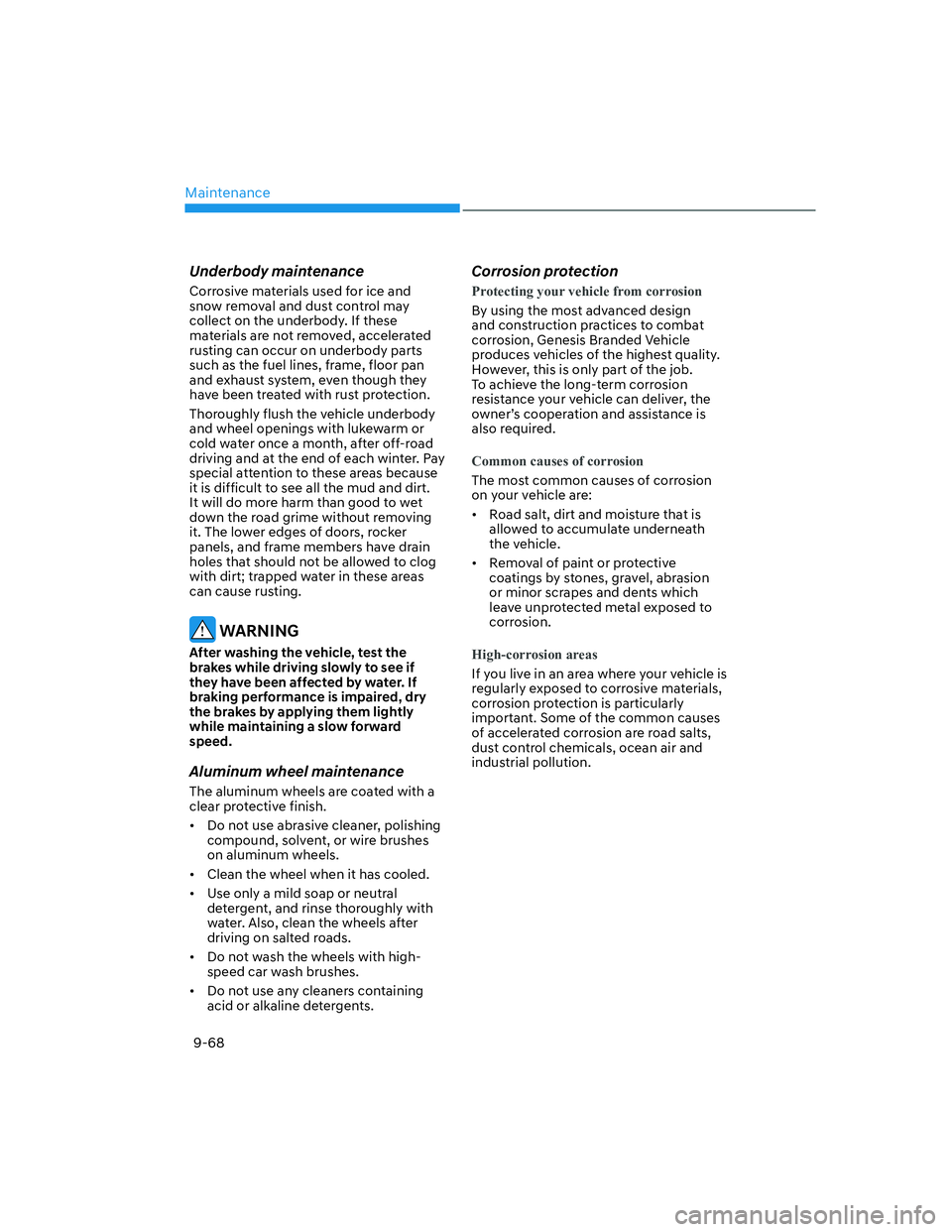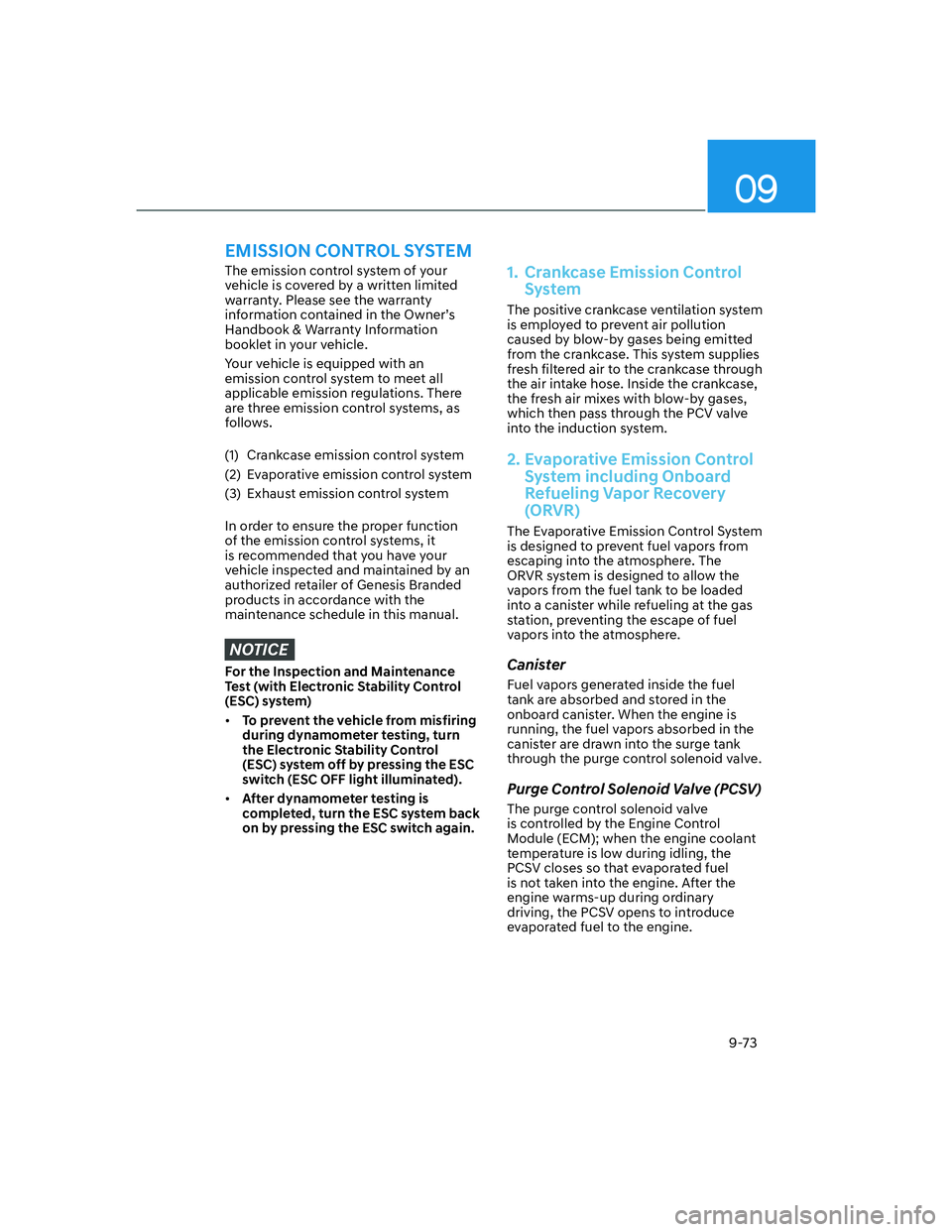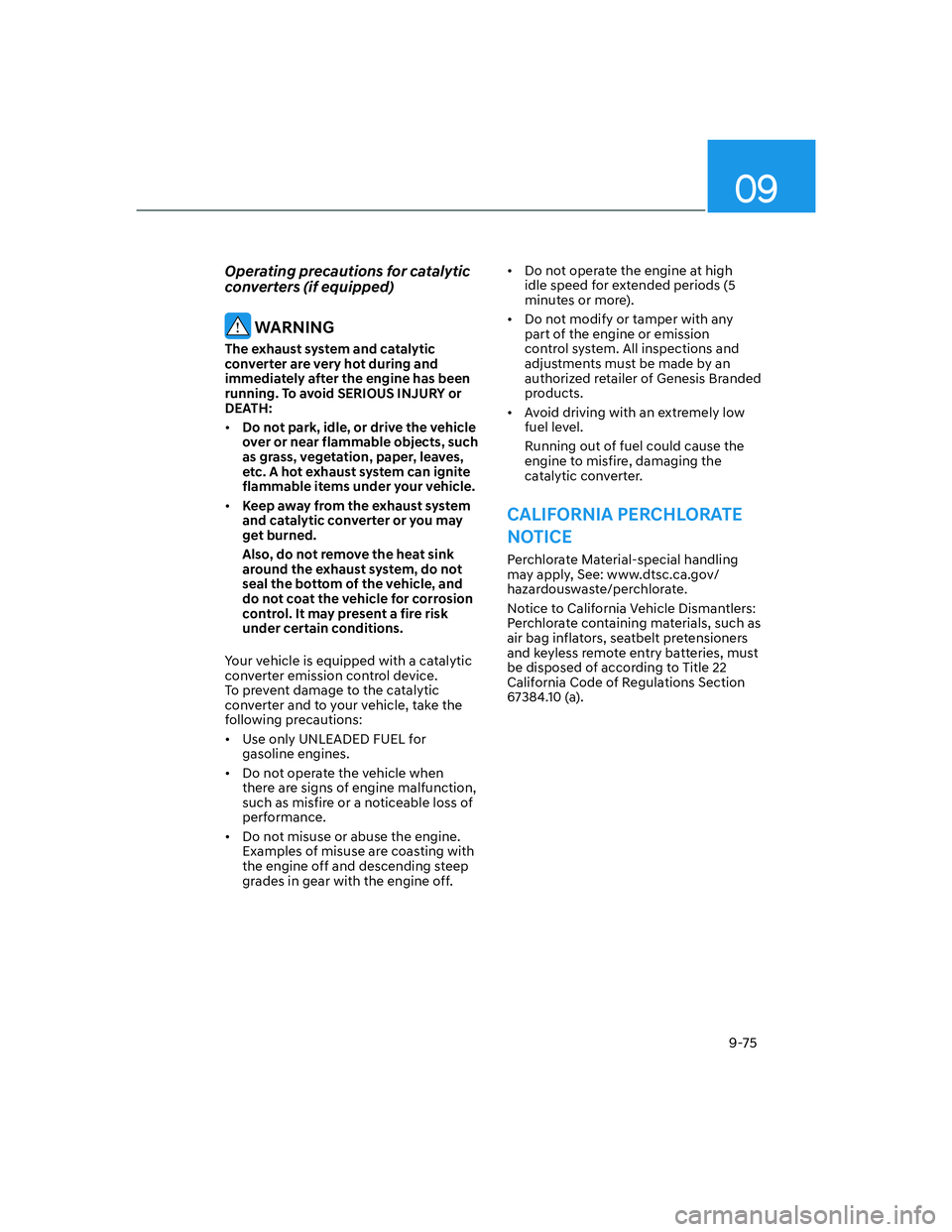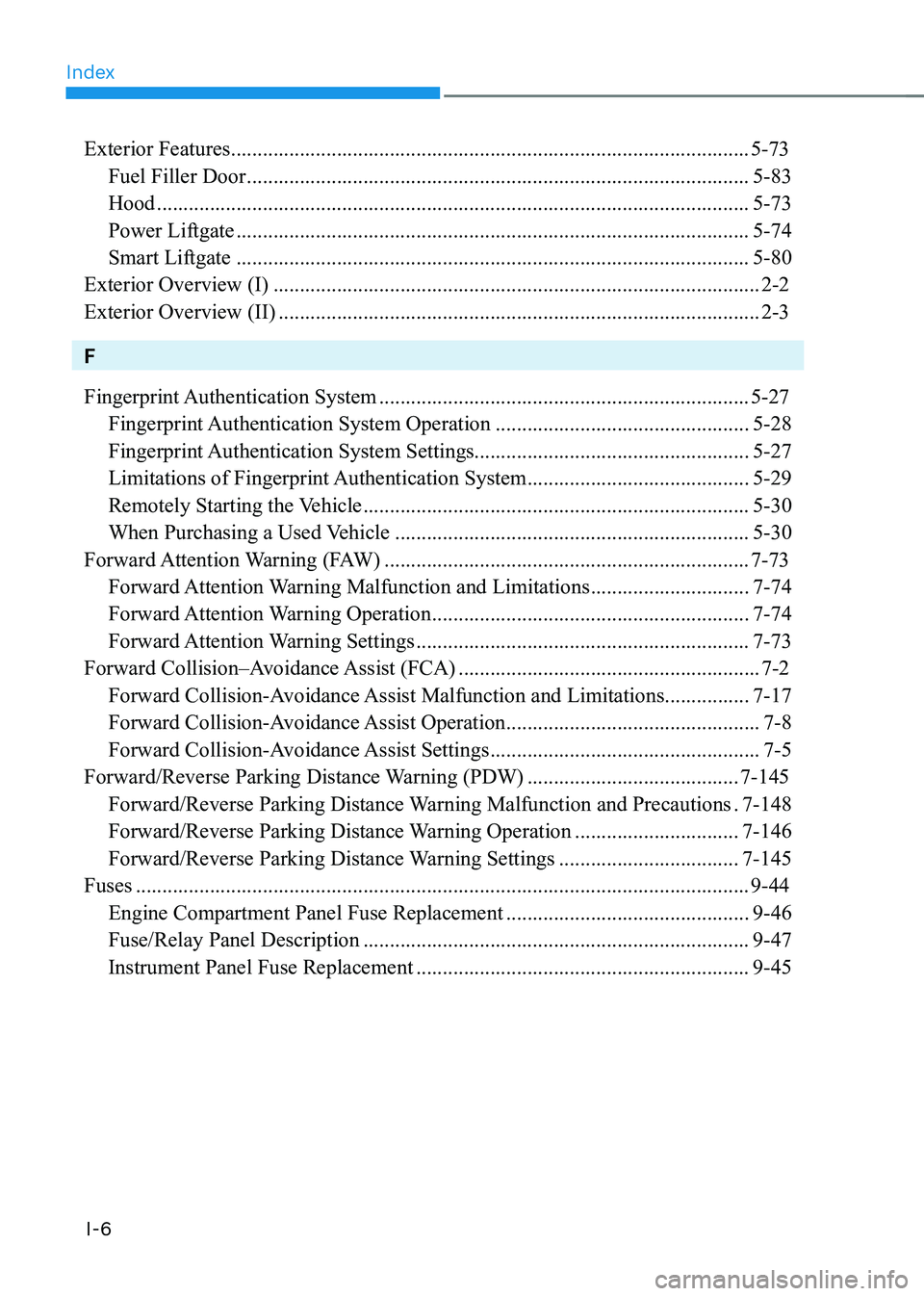2022 HYUNDAI GENESIS GV70 fuel
[x] Cancel search: fuelPage 625 of 647

Maintenance
9-68
Underbody maintenance
Corrosive materials used for ice and
snow removal and dust control may
collect on the underbody. If these
materials are not removed, accelerated
rusting can occur on underbody parts
such as the fuel lines, frame, floor pan
and exhaust system, even though they
have been treated with rust protection.
Thoroughly flush the vehicle underbody
and wheel openings with lukewarm or
cold water once a month, after off-road
driving and at the end of each winter. Pay
special attention to these areas because
it is difficult to see all the mud and dirt.
It will do more harm than good to wet
down the road grime without removing
it. The lower edges of doors, rocker
panels, and frame members have drain
holes that should not be allowed to clog
with dirt; trapped water in these areas
can cause rusting.
WARNING
After washing the vehicle, test the
brakes while driving slowly to see if
they have been affected by water. If
braking performance is impaired, dry
the brakes by applying them lightly
while maintaining a slow forward
speed.
Aluminum wheel maintenance
The aluminum wheels are coated with a
clear protective finish.
• Do not use abrasive cleaner, polishing
compound, solvent, or wire brushes
on aluminum wheels.
• Clean the wheel when it has cooled.
• Use only a mild soap or neutral
detergent, and rinse thoroughly with
water. Also, clean the wheels after
driving on salted roads.
• Do not wash the wheels with high-
speed car wash brushes.
• Do not use any cleaners containing
acid or alkaline detergents.
Corrosion protection
Protecting your vehicle from corrosion
By using the most advanced design
and construction practices to combat
corrosion, Genesis Branded Vehicle
produces vehicles of the highest quality.
However, this is only part of the job.
To achieve the long-term corrosion
resistance your vehicle can deliver, the
owner’s cooperation and assistance is
also required.
Common causes of corrosion
The most common causes of corrosion
on your vehicle are:
• Road salt, dirt and moisture that is
allowed to accumulate underneath
the vehicle.
• Removal of paint or protective
coatings by stones, gravel, abrasion
or minor scrapes and dents which
leave unprotected metal exposed to
corrosion.
High-corrosion areas
If you live in an area where your vehicle is
regularly exposed to corrosive materials,
corrosion protection is particularly
important. Some of the common causes
of accelerated corrosion are road salts,
dust control chemicals, ocean air and
industrial pollution.
Page 630 of 647

09
9-73
The emission control system of your
vehicle is covered by a written limited
warranty. Please see the warranty
information contained in the Owner’s
Handbook & Warranty Information
booklet in your vehicle.
Your vehicle is equipped with an
emission control system to meet all
applicable emission regulations. There
are three emission control systems, as
follows.
(1) Crankcase emission control system
(2) Evaporative emission control system
(3) Exhaust emission control system
In order to ensure the proper function
of the emission control systems, it
is recommended that you have your
vehicle inspected and maintained by an
authorized retailer of Genesis Branded
products in accordance with the
maintenance schedule in this manual.
NOTICE
For the Inspection and Maintenance
Test (with Electronic Stability Control
(ESC) system)
• To prevent the vehicle from misfiring
during dynamometer testing, turn
the Electronic Stability Control
(ESC) system off by pressing the ESC
switch (ESC OFF light illuminated).
• After dynamometer testing is
completed, turn the ESC system back
on by pressing the ESC switch again.
1. Crankcase Emission Control
System
The positive crankcase ventilation system
is employed to prevent air pollution
caused by blow-by gases being emitted
from the crankcase. This system supplies
fresh filtered air to the crankcase through
the air intake hose. Inside the crankcase,
the fresh air mixes with blow-by gases,
which then pass through the PCV valve
into the induction system.
2. Evaporative Emission Control
System including Onboard
Refueling Vapor Recovery
(ORVR)
The Evaporative Emission Control System
is designed to prevent fuel vapors from
escaping into the atmosphere. The
ORVR system is designed to allow the
vapors from the fuel tank to be loaded
into a canister while refueling at the gas
station, preventing the escape of fuel
vapors into the atmosphere.
Canister
Fuel vapors generated inside the fuel
tank are absorbed and stored in the
onboard canister. When the engine is
running, the fuel vapors absorbed in the
canister are drawn into the surge tank
through the purge control solenoid valve.
Purge Control Solenoid Valve (PCSV)
The purge control solenoid valve
is controlled by the Engine Control
Module (ECM); when the engine coolant
temperature is low during idling, the
PCSV closes so that evaporated fuel
is not taken into the engine. After the
engine warms-up during ordinary
driving, the PCSV opens to introduce
evaporated fuel to the engine.
EMISSION CONTROL SYSTEM
Page 632 of 647

09
9-75
Operating precautions for catalytic
converters (if equipped)
WARNING
The exhaust system and catalytic
converter are very hot during and
immediately after the engine has been
running. To avoid SERIOUS INJURY or
DEATH:
• Do not park, idle, or drive the vehicle
over or near flammable objects, such
as grass, vegetation, paper, leaves,
etc. A hot exhaust system can ignite
flammable items under your vehicle.
• Keep away from the exhaust system
and catalytic converter or you may
get burned.
Also, do not remove the heat sink
around the exhaust system, do not
seal the bottom of the vehicle, and
do not coat the vehicle for corrosion
control. It may present a fire risk
under certain conditions.
Your vehicle is equipped with a catalytic
converter emission control device.
To prevent damage to the catalytic
converter and to your vehicle, take the
following precautions:
• Use only UNLEADED FUEL for
gasoline engines.
• Do not operate the vehicle when
there are signs of engine malfunction,
such as misfire or a noticeable loss of
performance.
• Do not misuse or abuse the engine.
Examples of misuse are coasting with
the engine off and descending steep
grades in gear with the engine off.• Do not operate the engine at high
idle speed for extended periods (5
minutes or more).
• Do not modify or tamper with any
part of the engine or emission
control system. All inspections and
adjustments must be made by an
authorized retailer of Genesis Branded
products.
• Avoid driving with an extremely low
fuel level.
Running out of fuel could cause the
engine to misfire, damaging the
catalytic converter.
CALIFORNIA PERCHLORATE
NOTICE
Perchlorate Material-special handling
may apply, See: www.dtsc.ca.gov/
hazardouswaste/perchlorate.
Notice to California Vehicle Dismantlers:
Perchlorate containing materials, such as
air bag inflators, seatbelt pretensioners
and keyless remote entry batteries, must
be disposed of according to Title 22
California Code of Regulations Section
67384.10 (a).
Page 637 of 647

I
I-5
E
Electronically Controlled Suspension with Road Preview ..................................6-43
Limitations of the System ........................................................................\
.......6-44
System Malfunction ........................................................................\
................6-44
Electronic Control Suspension ........................................................................\
....6-43
System Malfunction ........................................................................\
................6-43
Electronic Limited Slip Differential ....................................................................6-42
Drive Mode Selection ........................................................................\
.............6-42
Warning Messages........................................................................\
...................6-42
Emission Control System ........................................................................\
............9-73
Crankcase Emission Control System ..............................................................9-73
Evaporative Emission Control System including Onboard Refueling Vapor Recovery (ORVR) ........................................................................\
...................9-73
Exhaust Emission Control System ..................................................................9-74
Engine ........................................................................\
............................................2-8
Engine Compartment ........................................................................\
.....................9-3
Engine Compartment ........................................................................\
.....................2-7
Engine Coolant/Liquid-Cooled Intercooler Coolant ...........................................9-18
Changing Coolant........................................................................\
....................9-20
Checking the Coolant Level ........................................................................\
....9-18
Engine Number ........................................................................\
............................2-15
Engine Oil ........................................................................\
....................................9-15
Checking the Engine Oil and Filter .................................................................9-17
Checking the Engine Oil Level .......................................................................9-15
Engine Start/Stop Button ........................................................................\
...............6-5
Engine Stop/Start Button Positions ...................................................................6-6
Remote Start ........................................................................\
..............................6-9
Starting the Engine ........................................................................\
....................6-7
Turning Off the Engine ........................................................................\
.............6-8
Explanation of Scheduled Maintenance Items ....................................................9-13
Exterior Features ........................................................................\
........................5-137
Roof Side Rails ........................................................................\
.....................5-137
Page 638 of 647

Index
I-6
Exterior Features ........................................................................\
..........................5-73
Fuel Filler Door ........................................................................\
.......................5-83
Hood ........................................................................\
........................................5-73
Power Liftgate ........................................................................\
.........................5-74
Smart Liftgate ........................................................................\
.........................5-80
Exterior Overview (I) ........................................................................\
....................2-2
Exterior Overview (II) ........................................................................\
...................2-3
F
Fingerprint Authentication System ......................................................................5-27
Fingerprint Authentication System Operation ................................................5-28
Fingerprint Authentication System Settings....................................................5-27
Limitations of Fingerprint Authentication System ..........................................5-29
Remotely Starting the Vehicle ........................................................................\
.5-30
When Purchasing a Used Vehicle ...................................................................5-30
Forward Attention Warning (FAW) .....................................................................7-73
Forward Attention Warning Malfunction and Limitations ..............................7-74
Forward Attention Warning Operation ............................................................7-74
Forward Attention Warning Settings ...............................................................7-73
Forward Collision–Avoidance Assist (FCA) .........................................................7-2
Forward Collision-Avoidance Assist Malfunction and Limitations ................7-17
Forward Collision-Avoidance Assist Operation ................................................7-8
Forward Collision-Avoidance Assist Settings ...................................................7-5
Forward/Reverse Parking Distance Warning (PDW) ........................................7-145
Forward/Reverse Parking Distance Warning Malfunction and Precautions .7-148
Forward/Reverse Parking Distance Warning Operation ...............................7-146
Forward/Reverse Parking Distance Warning Settings ..................................7-145
Fuses ........................................................................\
............................................9-44
Engine Compartment Panel Fuse Replacement ..............................................9-46
Fuse/Relay Panel Description ........................................................................\
.9-47
Instrument Panel Fuse Replacement ...............................................................9-45